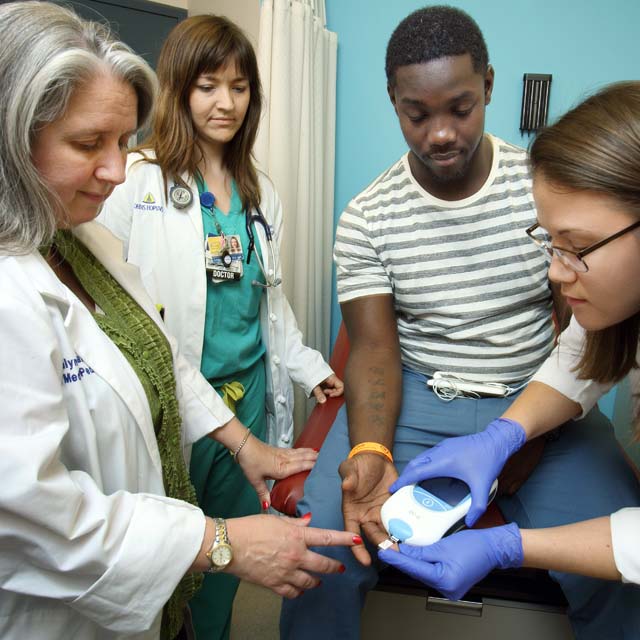After-Care Clinic: A Bridge for Patients at Risk
Pilot program offers timely follow-up care and services.

Pharmacist Amanda Sowell checks Deron Bridges’ blood-thinning level, as After-Care Clinic co-director Rosalyn Stewart, far left, and emergency medicine physician Anneliese Cuttle look on.
By the time Deron Bridges arrived at the Johns Hopkins Hospital Emergency Department in late April, he was struggling to breathe. He also had an active cough and chest pain. Bridges, 24, has a history of asthma and recurring pulmonary embolisms—sudden blockages in a lung artery. The condition places him at high risk for life-threatening blood clots.
Bridges developed severe symptoms after not taking his daily blood thinner pill for an extended period. On discharge, a nurse advised him to resume taking his medication. Then she scheduled an appointment for the following week for Bridges to see a doctor at the recently opened After-Care Clinic.
This new protocol, says internist Rosalyn Stewart, who co-directs the clinic with emergency medicine physician Arjun Chanmugam, improves the odds that patients who struggle with managing their health will avoid further emergency care or readmission to the hospital.
A joint effort among the departments of Medicine, Emergency Medicine, Care Coordination, Ambulatory Services, Surgery and Pharmacy, the After-Care Clinic serves as a safety net for these patients. Its goal: to extend primary care services for those in need of rapid follow-up—within a week after discharge from the hospital or evaluation in the ED.
Located on the seventh floor of the Johns Hopkins Outpatient Center and open Mondays, Wednesdays and Thursdays from 4:30 to 7 p.m., the clinic offers medical evaluation, blood work, lab tests, pharmacy access, education and social services.
The new clinic mirrors national efforts to keep patients released from the hospital on top of their health care needs. A recent study by the Center for Studying Health System Change, a Washington, D.C.-based research group, found that roughly one-third of adult patients discharged from the hospital don’t see a physician within the advised 30 days. Experts say that’s a key reason so many are readmitted.
“Patients coming to the hospital are sicker than they’ve ever been,” says Melissa Richardson, The Johns Hopkins Hospital’s director of clinical resource management. “So when we send them home, we need to make sure they have what they need to manage and to get follow-up.”
Over time, adds Stewart, “we want to make the After-Care Clinic an entry point for patients into a ‘medical home’ that connects them with Johns Hopkins primary care—the place where they can receive comprehensive services and patient education continuously under one roof.”
The After-Care Clinic is not an urgent care center, nor is it a primary care office, explains Stewart. Rather, it provides a setting where patients can be assessed, treated and transitioned to a community provider.
There’s also a financial reason for the clinic. Under new Medicare laws, hospitals are responsible for patients 30 days postdischarge and can incur substantial penalties for patients who are readmitted unnecessarily.
Six days after his ED visit, Bridges arrives for his clinic appointment. He tells Stewart and nurse practitioner Nancy Feeley that he’s doing OK.
“Good news,” says Feeley. “Your CT scan shows no pneumonia.” She listens to his chest and hears a murmur. “That could be because of clots in your lungs.” Stewart dons a stethoscope, listens and agrees. Then, after taking a drop of blood and using specialized equipment, pharmacist Amanda Sowell discovers that his blood-thinning index is 1.
“Getting to 2 is your goal,” says Sowell. She and Stewart tell Bridges to continue on the second blood thinner prescribed the previous week. Before he leaves, Feeley reminds him to schedule a follow-up appointment with a primary care provider to chart his progress.
Despite the clinic’s best efforts, however, patients can fall through the cracks. Many, says Stewart, fail to provide their phone number. And about 50 percent of scheduled patients don’t show up for appointments.
For Bridges, who lives just blocks from The Johns Hopkins Hospital, the After-Care Clinic feels natural. “When I was growing up, Hopkins was a second home for my family, like when I got hurt playing football,” he says. “My aunts, uncles and grandparents all came here too.”
If Stewart has her way, The Johns Hopkins Hospital will become his—as well as other clinic patients’—medical home. Meanwhile, she hopes to expand the clinic model at other Johns Hopkins hospitals.